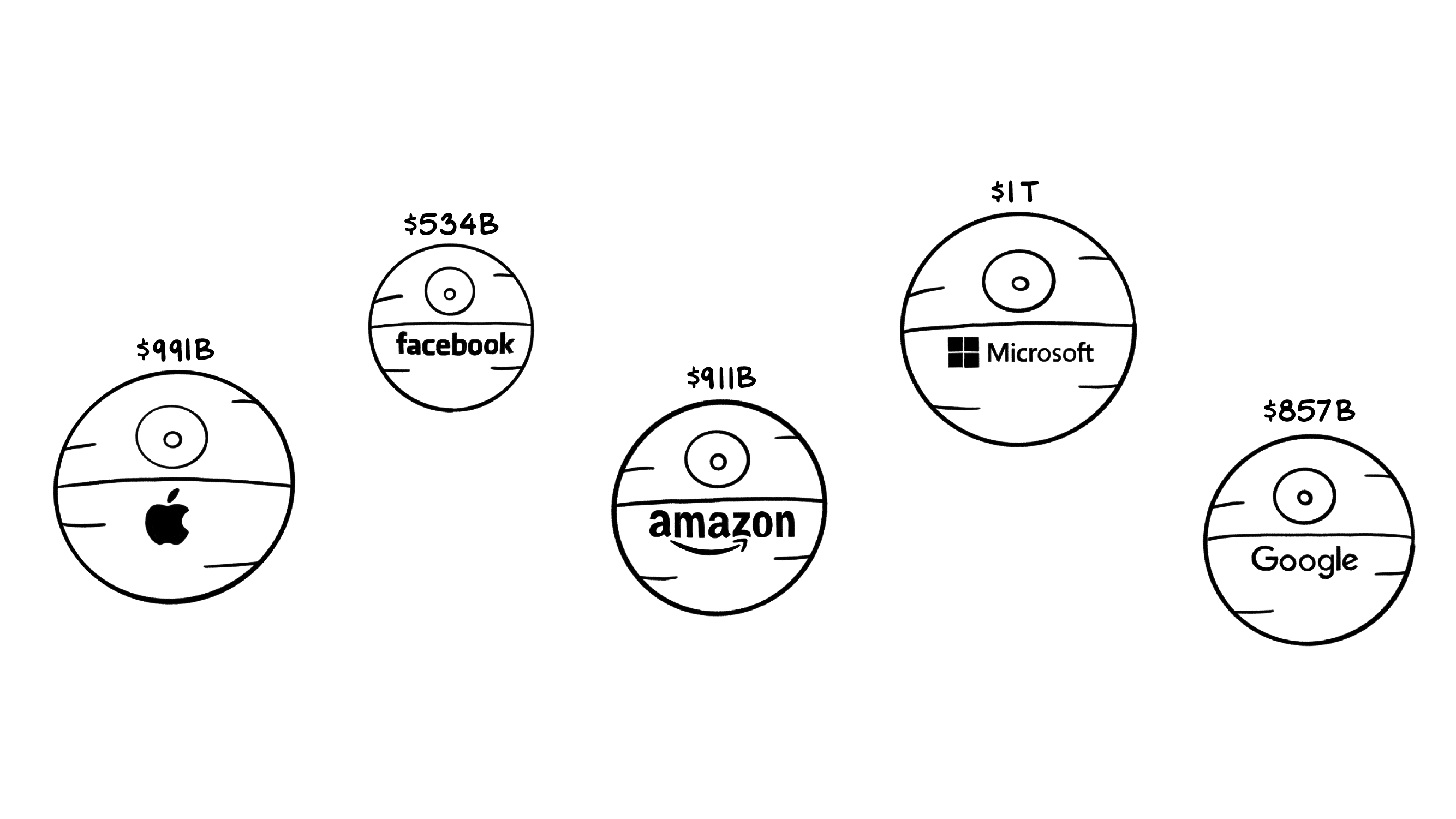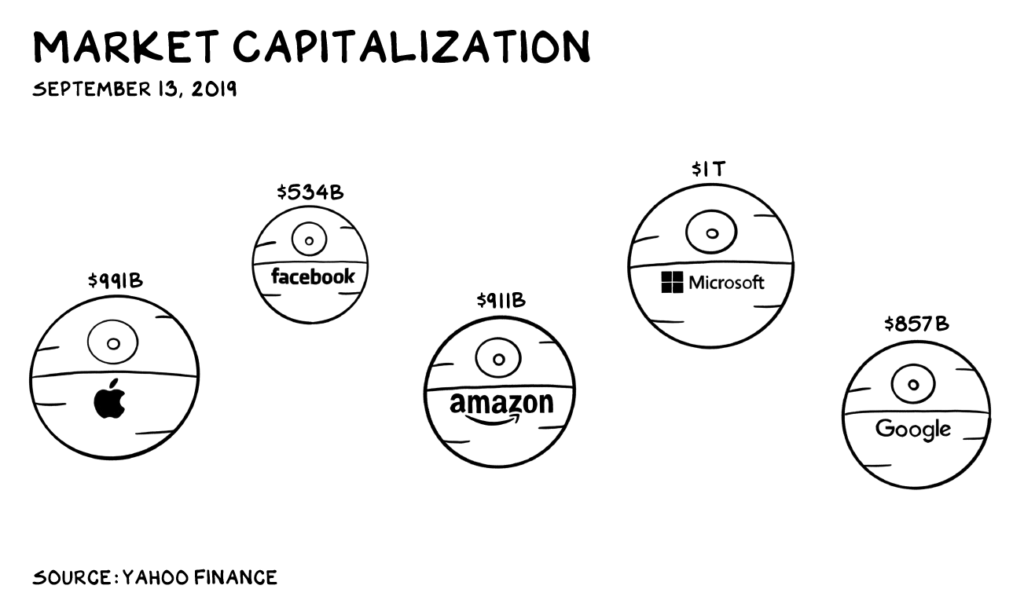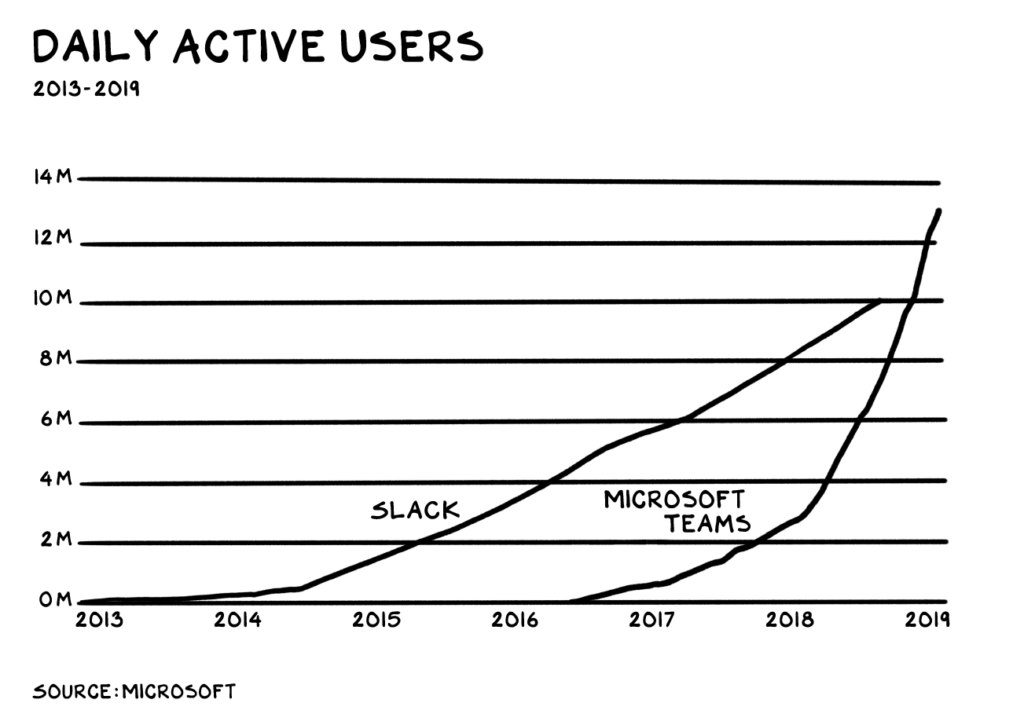
Search Your Feelings
They started out benign, a group committed to peace and prosperity in the galaxy. Slowly, they aggregated power and, wanting to maintain that power, turned to the dark side. They built a weapon 900km in diameter, staffed by hundreds of thousands of personnel and robots. Of course I’m talking about the DS-1 Orbital Battle Station commanded by Governor Tarkin — and also Amazon, Apple, Facebook, Google, and Microsoft.
The Death Stars of our economy can use bundling and economic power to add services and features that can destroy a promising business, at the speed of light. The Death Stars of our galaxy:
- iOS — 1 billion installed base
- Facebook — 2.7 billion installed base
- Android — 2.5 billion installed base
- Amazon — 82 percent of US households
- Microsoft Office — 1.2 billion users
Governor Tarkin destroyed the planet Alderaan outright. But with his second Death Star, he checked back a bit, recognizing the blatant destruction of a planet made you much less likable, and subject to antitrust scrutiny.

The Death Star has multiple reactors, which, when united, can cause the total destruction of a planet. But when trying to destroy something specific, Governor Tarkin orders a single-reactor ignition. This is still overkill for a city or a base, but nowhere near enough power to destroy an entire planet.
After obliterating Netscape and inviting antitrust action, the then-fastest growing company in history, Microsoft, decided to kill other planets/firms more slowly. The Seattle giant has turned a single-reactor laser on Slack, the cloud-based team collaboration software. Made by a gaming firm that hacked a better way for teams to work together, the software has captured a loyal following, including half of the top-100 companies.
At our firm, I clearly don’t get it — for a host of reasons — as evidenced by my refusal to give up email and start slacking everyone. When I’m on Slack, similar to Snap, I feel I’m going to slip and break a hip.
Slack has carved out a great business with all the makings of a giant — recurring revenue, network effects, explosive growth.
Via a direct listing, bypassing bankers, Slack began trading last month (NASDAQ: WORK), garnering a market capitalization of $19.5 billion, a value similar to Kroger. But the reactors have been fired up at Microsoft, and since the IPO, Slack has shed 33% of its value. Some of this, regardless of the threat of imminent destruction, is that, at 49x revenues, the company was likely overvalued. However, the chart below is what a superlaser from a moon base looks like.

Microsoft is bundling their collaboration tool, Teams, with Microsoft Office and charging as little as $5 per user (for the basic subscription) vs. Slack’s $6.67. I’m sure Microsoft would like to turn on multiple reactors and make Teams free and ubiquitous across all Windows devices, similar to Internet Explorer. But Microsoft doesn’t want to give everyone déjà vu of the nineties. Not awesome déjà vu — Robin Williams or the Taco Bell Chihuahua, but Blockbuster late fees on Cousins (Ted Danson’s cinematic peak) déjà vu.
Slack is a great product and a great company, and it will shed another 20-50% of its value in the next six months as the Seattle Death Star comes in clearer view. If Microsoft wants to go full Celine Dion on Slack, they’d offer it for free and train their sales reps to spread fear among CTOs, convincing them that Slack is a security risk.
But Microsoft would be better off to kill it slowly. Satya (so fu*king likable) has done a formidable job recasting the firm as Anakin Skywalker’s ghost, hanging with Yoda in tech heaven. It may take years or happen in an instant. I worry the superlaser has already left the Microsoft moon base. It’s just a matter of time — a brief respite, as even light takes a minute to travel 11 million miles. But the laser is on its way.
Apple and Disruption
The Death Stars of our modern economy can obliterate planets. A single reactor fire has hit Spotify from Apple, as they control the distribution (app store) and are neutering the Swedish firm. Planet Spotify has been rendered sterile and now needs to find other business models — original content, podcasts, or controlled distribution via its own device.
The shocker for me in the recent launch of Apple TV+ was that in 2018, the estimated spend on original content from Apple was pegged at a cool $1 billion. But last month they announced $6 billion for original content. So, a tech hardware firm is devoting the same capital to shows with Reese Witherspoon and Jason Mamoa as the state of California allocates to the 23 campuses that make up the California State University system. If it sounds as if we’re living in a dystopia, trust your instincts.
Apple TV+ will be all original content, at $4.99/month. For every $1 that you spend a month, the company spends $1 billion on content a year, just like Netflix, so Apple is “disruptive.” The greatest unlock, other than Prime, in the history of business was Apple’s decision to go vertical with a multibillion-dollar investment in stores to control the brand. They’ve made a similar investment here, with a nod to what’s still their core asset, the brand. Even if the quality of the content isn’t HBO-like, not having Daddy’s Home 2 next to original content sends a cleaner brand message. Apple continues to be the benchmark of brand management.
Under Attack
The superweapon is an installed base built via vertical distribution. The only firm that has been able to achieve near–Death Star status, without controlling the distribution, is Netflix. Reed Hastings is a first-ballot Hall of Fame business rockstar. I now believe Netflix will likely shed value over the next three years as Death Stars begin to bundle content across their own devices, distribution, and loyalty programs.
The gangster move would be if Netflix acquires Sony, capturing a ton of content and vertical distribution — game consoles and TVs. The streaming giant could then offer the grand bargain rundle and, for $29, $39, or $49/month, provide households with Netflix on all their entertainment appliances — different levels (silver, gold, and platinum) depending on how cool the appliance.
Apple is also in a position to offer a Prime-like rundle. Just send me the latest iWhatever (Mac/pods/watch) with unlimited media cued up for $50/month. Firms have yet to fully exploit the arbitrage between the pace of time, and our perception of the pace of time. I work out 4x/week, so Equinox is only costing me $15 per workout. No, I’m actually there 4x/month, so it costs me $60 to hang out with hot gay men in Lululemon #worthit.
Rebel Force
The rebel force here is capitalism, which depends on a more robust ecosystem and competition. The dark side has forced capitalism to the ice planet Hoth. Princess Leia (Margrethe Vestager) has rallied her forces. But without an army of Jedi, we are doomed to an economy of darkness: inequality, teen depression, tax avoidance, and the co-opting of our government by private influence — a key step to tyranny. DC has turned to the dark side, and is the servant of emperor Palpatine.
It’s not too late. We see the light in you, our elected officials. The 48 attorneys general who came together this week and announced they are making plans to break up the search engine Death Star, may be the turning point in the rebellion. If tech monopolies are broken up, our economy would have more hiring, a broader tax base, more competition, more secure elections, and less teen depression. Search your feelings. You know this to be true.
Life is so rich,

P.S. Making weekly videos again — for more on how Spotify could fight back against Apple Music, go to our YouTube channel.
19 Comments
Need more Scott in your life?
The Prof G Markets Pod now has a newsletter edition. Sign up here to receive it every Monday. What a thrill.


awesome observation. thanks man!
Capitalism isn’t the rebels, its the medium. No matter the medium, whether its corporations or feudal lords, they’re all trying to co-opt the process and build the deathstar-of-their-era. There is no need to wonder why DC is “corrupted”, there has never been a time it “pure” either.
The Teams vs Slack users chart might be misleading. I am a “user” of both Slack and Teams because my company has both (the latter via Office 365), but we are all on Slack all day every day and only go to Teams when forced to. You could bin Teams and nobody would give a damn, but you’d have to pry Slack from our cold, dead hands.
I wish you were the president, Scott.
So, specifically, what does “break up” the tech monoliths actually look like. If Apple is broken into pieces, what are they and how does that benefit the market?
cracking article
Its all illegal immigrants’ faults
But Professor, You’ve said yourself, on podcasts, that you only own stock in tech behemoths. Just what color is your light saber?
green
He owns these companies because he understands their advantages in this ecosystem. After writing the above essay, why would he do anything else?
Well, obviously you wouldn’t bet on the company that is to lose.
Ok, so I shouldn’t be holding WORK?
Be careful that you do not gain the attention of the Emperor. He may be a feeble old fool, but those that control him are not, and the lasers could be powering up right now. At least get a blaster and find the nearest garbage chute to dive into. And use the force (Slack).
Another classic, Scott…please forward your email to the 48 state AGs…who were the 2 idiots who took a pass on this?
Legend.
excellent observations as usual from a 21st century StarWars economist…bully and bravo…peace.
REALLY enjoy your perspective … I thought the excitement of the apple conf. this week was a good (absurd) example – your metaphorical world far more graceful depiction. regards from Mpls
Great article. Thanks Master
I want the Apple rundle at $50/mo. #toomanychoices